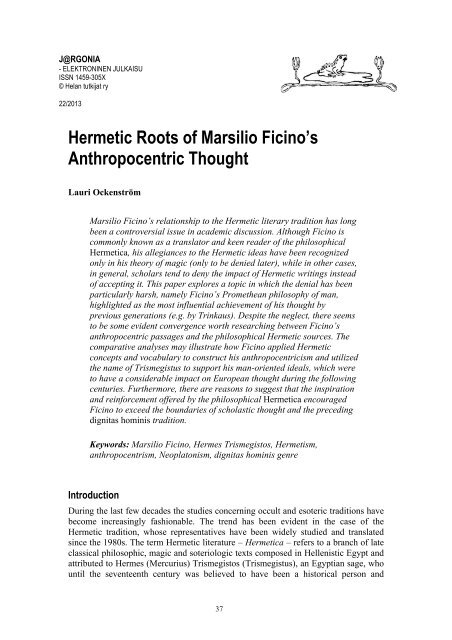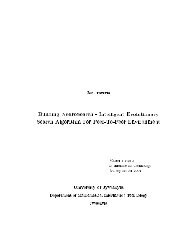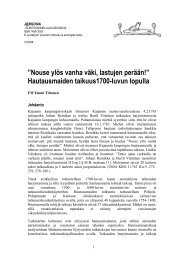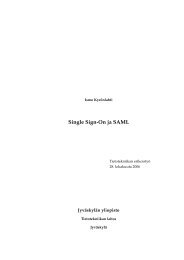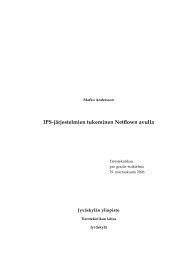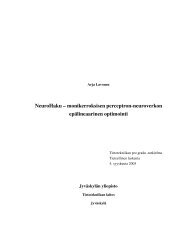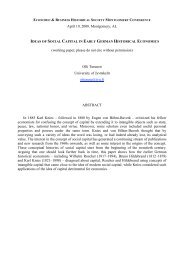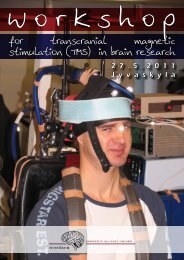Hermetic Roots of Marsilio Ficino's Anthropocentric Thought
Hermetic Roots of Marsilio Ficino's Anthropocentric Thought
Hermetic Roots of Marsilio Ficino's Anthropocentric Thought
You also want an ePaper? Increase the reach of your titles
YUMPU automatically turns print PDFs into web optimized ePapers that Google loves.
J@RGONIA- ELEKTRONINEN JULKAISUISSN 1459-305X© Helan tutkijat ry22/2013<strong>Hermetic</strong> <strong>Roots</strong> <strong>of</strong> <strong>Marsilio</strong> Ficino’s<strong>Anthropocentric</strong> <strong>Thought</strong>Lauri Ockenström<strong>Marsilio</strong> Ficino’s relationship to the <strong>Hermetic</strong> literary tradition has longbeen a controversial issue in academic discussion. Although Ficino iscommonly known as a translator and keen reader <strong>of</strong> the philosophical<strong>Hermetic</strong>a, his allegiances to the <strong>Hermetic</strong> ideas have been recognizedonly in his theory <strong>of</strong> magic (only to be denied later), while in other cases,in general, scholars tend to deny the impact <strong>of</strong> <strong>Hermetic</strong> writings instead<strong>of</strong> accepting it. This paper explores a topic in which the denial has beenparticularly harsh, namely Ficino’s Promethean philosophy <strong>of</strong> man,highlighted as the most influential achievement <strong>of</strong> his thought byprevious generations (e.g. by Trinkaus). Despite the neglect, there seemsto be some evident convergence worth researching between Ficino’santhropocentric passages and the philosophical <strong>Hermetic</strong> sources. Thecomparative analyses may illustrate how Ficino applied <strong>Hermetic</strong>concepts and vocabulary to construct his anthropocentricism and utilizedthe name <strong>of</strong> Trismegistus to support his man-oriented ideals, which wereto have a considerable impact on European thought during the followingcenturies. Furthermore, there are reasons to suggest that the inspirationand reinforcement <strong>of</strong>fered by the philosophical <strong>Hermetic</strong>a encouragedFicino to exceed the boundaries <strong>of</strong> scholastic thought and the precedingdignitas hominis tradition.Keywords: <strong>Marsilio</strong> Ficino, Hermes Trismegistos, Hermetism,anthropocentrism, Neoplatonism, dignitas hominis genreIntroductionDuring the last few decades the studies concerning occult and esoteric traditions havebecome increasingly fashionable. The trend has been evident in the case <strong>of</strong> the<strong>Hermetic</strong> tradition, whose representatives have been widely studied and translatedsince the 1980s. The term <strong>Hermetic</strong> literature – <strong>Hermetic</strong>a – refers to a branch <strong>of</strong> lateclassical philosophic, magic and soteriologic texts composed in Hellenistic Egypt andattributed to Hermes (Mercurius) Trismegistos (Trismegistus), an Egyptian sage, whountil the seventeenth century was believed to have been a historical person and37
J@rgonia 22/2013ISSN 1459-305XLauri Ockenström: <strong>Hermetic</strong> <strong>Roots</strong> <strong>of</strong> <strong>Marsilio</strong> Ficino’s <strong>Anthropocentric</strong> <strong>Thought</strong>and Alain de Lille discussed <strong>Hermetic</strong> topics known through the Latin Asclepius. Dueto Asclepius, the only influential representative <strong>of</strong> theoretical <strong>Hermetic</strong>a known at thatperiod, ‘Mercurius Trismegistus’ was during the thirteenth and fourteenth centuries arelatively widely cited author. Particularly the chapters 23–24 and 37–38, whichdescribe how Egyptian priests were able to ‘make gods’ by summoning divine soulsinto statues, were target <strong>of</strong> a vivid dispute, to which all remarkable writers took part.At the same period one segment <strong>of</strong> technical <strong>Hermetic</strong>a invaded Europe as Latintranslations <strong>of</strong> Arabic manuals <strong>of</strong> astrology, alchemy and talismanic magic. [3] Thetradition <strong>of</strong> Arabic Hermetism differed from the ancient tradition in many respects. Inmost <strong>of</strong> the cases the Arabic treatises written mostly between the seventh and eleventhcenturies have not been connected with any particular texts produced by the antiquity.(Copenhaver 1992, xlvi–xlvii.) These short tractates, however, probably reinforcedthe myth <strong>of</strong> Mercurius’s primordial origin, and, along with the Latin Asclepius,formed the late medieval understanding <strong>of</strong> <strong>Hermetic</strong> wisdom that Ficino inherited.Hermes was taken quite seriously by the Italian Renaissance. Petrarch is known tohave read Asclepius, and Giannozzo Manetti, Ficino’s important predecessor in thedignitas tradition, cites ‘Mercurius’ in his De dignitate et excellentia hominis (Onman’s dignity and excellency) completed in 1452 or 1453. Mercurius was, however,due to Asclepius’s passage <strong>of</strong> making gods and Arabic technical <strong>Hermetic</strong>a, <strong>of</strong>tenassociated with astrological magic and demonology. It was Ficino who then reintroducedthe ancient philosophical gnosis on a wider scale to the Europeanaudience. As the story transmitted by Ficino himself reveals, a Pistoian monk calledLeonardo found a Greek manuscript containing a <strong>Hermetic</strong> compilation in aMacedonian monastery and transported it to Florence. Ficino was immediatelycommanded to put aside the Platonic corpus and grasp the <strong>Hermetic</strong> newcomer.Ficino’s translation, entitled as Pimander, was completed in April 1463 and becamelater a real bestseller. Young Ficino was still inexperienced as a thinker and translator,and his rather cautious and conservative reinterpretation contains certain oddities. He,for example, refuses to call the human soul ‘demonic’ as the Greek original requires,and uses instead a Christianized substitute ‘angelic’. [4] Ficino’s great role as atranslator and interpreter <strong>of</strong> the <strong>Hermetic</strong> corpus and as a distributor <strong>of</strong> <strong>Hermetic</strong>thought cannot, however, be underlined enough. Pimander was printed already in1471, and by 1550 more than twenty editions had seen the light <strong>of</strong> day. Ficino’sPimander remained a standard version <strong>of</strong> the so-called Corpus <strong>Hermetic</strong>um until thenineteenth century, and because <strong>of</strong> his efforts the <strong>Hermetic</strong> tradition was for twocenturies a notable player in European intellectual life culminating in GiordanoBruno’s great synthesis. (Copenhaver 1992, xlviii–xlix; Scarborough 1988, 20–21.)The Renaissance had regarded Hermes Trismegistus as a real person or divinity datingback to the days <strong>of</strong> Moses. The situation changed in 1614, when a Swiss CalvinistIsaac Casaubon proved that the <strong>Hermetic</strong> texts cannot be from earlier than theHellenistic age. After Casaubon’s revelation the appreciation <strong>of</strong> the <strong>Hermetic</strong>adiminished and the <strong>Hermetic</strong> tradition sank into the margins <strong>of</strong> Western culture.However, the change was slow and gradual: Isaac Newton at the end <strong>of</strong> theseventeenth century and Chevalier Ramsay still in the eighteenth century used40
J@rgonia 22/2013ISSN 1459-305XLauri Ockenström: <strong>Hermetic</strong> <strong>Roots</strong> <strong>of</strong> <strong>Marsilio</strong> Ficino’s <strong>Anthropocentric</strong> <strong>Thought</strong><strong>Hermetic</strong> texts as valuable historical sources. (Copenhaver 1992, l–li. Fowden 1993,xxii.)Ficino, <strong>Hermetic</strong>a and the Research TraditionGarth Fowden summarized the situation quite appositely in 1993 when he stated that‘historical and sociological questions about Hermetism have usually been regarded as<strong>of</strong> subordinate interest and important.’ (Fowden 1993, xxi–xxii.) It is still somehowmysterious how problematic a topic the <strong>Hermetic</strong> tradition has been for scholars sincethe modern research began at the dawn <strong>of</strong> the twentieth century. In the first half <strong>of</strong> thecentury trends like logical positivism regarded disapprovingly everything that waslabelled as irrational, and phenomena like Hermetism and magic were usually seen asunworthy topics for academic research. This enlightened and ‘classical’ attitudedominated also the Ficinian studies for decades. During the first half <strong>of</strong> the centuryTrismegistus was never mentioned among Ficino’s sources. For example, Paul OskarKristeller and Giuseppe Saitta, who composed influential monographs on Ficino’s lifeand thought, designated him as a representative <strong>of</strong> the classical tradition and purelyChristian scholastic thought without linkages to <strong>Hermetic</strong> texts or other esotericsources. In the 1950s the situation started to change when Eugenio Garin andWarburgian scholars D. P. Walker and Frances Yates, who brought the history <strong>of</strong>occult sciences into the modern discussion on a larger scale, regarded Asclepius andCorpus <strong>Hermetic</strong>um as central sources for Ficino’s magical and astrological thought.[5] The emphasise on the <strong>Hermetic</strong> influence led to some ambitious and exaggeratingclaims suggesting that the rise <strong>of</strong> experimental methodologies and even the wholescientific revolution was partly due to the strong <strong>Hermetic</strong> vibrations <strong>of</strong> the sixteenthcentury. This so-called ‘Yates thesis’ has been highly controversial from the verybeginning, but it gained a foothold nevertheless and one can still encounter its echoesin histories <strong>of</strong> philosophy. [6]Meanwhile, there were strong academic tendencies to restrict the <strong>Hermetic</strong> impulsemerely to magical and occult thought. These attitudes are manifest in the works <strong>of</strong>Charles Trinkaus, who in 1970 argued that Ficino and Pico ‘did not need HermesTrismegistus to show them way’ to delineate the new ideal <strong>of</strong> human dignity.Trinkaus was convinced that the biblical Genesis, patristic sources and the humanistictradition were enough to explain the anthropocentric emphasis in Renaissancethought. He saw, in general, Ficino’s anthropocentric philosophy as a classical projectthat had few if any connections to the occult disciplines like the suspicious and non-European <strong>Hermetic</strong> tradition. (Trinkaus 1970, 486–87, 501–503.)The connection between <strong>Hermetic</strong> sources and Ficino’s theory <strong>of</strong> magic served as aparadigmatic view until the 1980s, when Brian P. Copenhaver published notablestudies on the topic. Besides attacking harshly the Yates thesis he proved,convincingly enough, that the theoretical <strong>Hermetic</strong> texts familiar to Ficino <strong>of</strong>feredlittle if any material that was usable for the theory <strong>of</strong> magic, and that the real sourcesfor Ficino’s magic should be searched among scholastic philosophers and lateclassical Neoplatonists, such as Plotinus, Porphyrius, Iamblichus and Proclus. Later,Carol Kaske agreed with this view. (Copenhaver 1984, 523–554; 1986, 351–369;1988, 79–110; Kaske 1998, 47–48.) Besides, when Michael J. B. Allen in 199041
J@rgonia 22/2013ISSN 1459-305XLauri Ockenström: <strong>Hermetic</strong> <strong>Roots</strong> <strong>of</strong> <strong>Marsilio</strong> Ficino’s <strong>Anthropocentric</strong> <strong>Thought</strong>argued that Ficino ‘never became, or at least remained, a committed Hermetist, andthe impact <strong>of</strong> the Corpus <strong>Hermetic</strong>um upon his thought was early and limited’ (Allen1990, 47), it seemed that the supposed connections between <strong>Hermetic</strong>a and Ficino’sthought – both magical and philosophical – had been largely demolished.Since then there have been only a few efforts to re-examine Ficino’s <strong>Hermetic</strong>linkages. In 2002 Clement Salaman, working within Allen’s sphere <strong>of</strong> influence, triedto establish nexuses between Ficino’s theoretical philosophy and some <strong>Hermetic</strong>conceptions <strong>of</strong> Egyptian origin. The parallels he highlighted, for example the sun as asymbol <strong>of</strong> divine light, are obvious, though the conceptions in question are notexclusively <strong>Hermetic</strong> but more likely common features in all Neoplatonic literature, apoint that makes it challenging to identify the specific sources. (Salaman 2002, 115–135.)[7] What is remarkable in Salamans’s study, however, is his cautious assumption<strong>of</strong> continuous <strong>Hermetic</strong> influence on Ficino throughout his career, not limited tomagic but spread also across the fields <strong>of</strong> philosophy.Ficino’s Theoretical <strong>Hermetic</strong>a: Asclepius and PimanderFicino knew two remarkable representatives <strong>of</strong> the theoretical <strong>Hermetic</strong>a. A <strong>Hermetic</strong>compilation known as Asclepius is a philosophical and theological dialogue consisting<strong>of</strong> forty-one chapters. The treatise was originally written in Greek in the second orthird century AD entitled as Logos teleios, the Perfect Sermon. The Latin nameAsclepius derives from Greek Asklepios, a Hellenistic interpretation <strong>of</strong> the Egyptiangod Imhotep or Imouthes, who appears as one <strong>of</strong> the characters <strong>of</strong> the dialogue.Lactantius seems to have known the Greek original that did not survive. The Latintranslation, which was falsely attributed to the Apuleius <strong>of</strong> Madaura, the famousauthor <strong>of</strong> Metamorphoses, was mentioned in Augustine’s City <strong>of</strong> God at the beginning<strong>of</strong> the fifth century. The themes that the treatise deals with are, according to JohnScarborough, typical <strong>of</strong> the third-century pagan philosophical debates. Asclepiusdiscusses the doctrine <strong>of</strong> elements, the origin <strong>of</strong> forms and matter as well as themortality and immortality <strong>of</strong> living things. Man as a reflection <strong>of</strong> God with God’sattributes and man’s ranking behind God are also substantial themes. (Copenhaver1992, xiii, xliii–xliv; Scarborough 1988, 25.) <strong>Anthropocentric</strong> tones culminate inchapters 6 and 8, which praise the divinity <strong>of</strong> the human soul and the variety <strong>of</strong> humanskills. The manuscript Ficino used has not been identified, but the Latin Asclepiusappears as a notable source <strong>of</strong> citations throughout his career. The impact is mostconspicuous in Theologia Platonica and De vita, but certain choices in his Pimandertranslation indicate that he was probably well acquainted with the Latin Asclepiusalready in 1462.Because Pimander is <strong>of</strong>ten confused with the so-called Corpus <strong>Hermetic</strong>um, someexplicatory notions might be necessary. Corpus <strong>Hermetic</strong>um is a Greek compilationconsisting <strong>of</strong> seventeen books formed by sixteenth century editors. Pimander isFicino’s Latin translation <strong>of</strong> the first fourteen books, and it is based on only one Greekmanuscript brought from Macedonia. The title, Pimander, is a Latinized form <strong>of</strong>Poimandres, the protagonist <strong>of</strong> the dialogue. The compilation translated by Ficino in1462–63 – as well as the whole Corpus <strong>Hermetic</strong>um – represents a different textualtradition than the survived examples <strong>of</strong> the ancient <strong>Hermetic</strong>a. The oldest surviving42
J@rgonia 22/2013ISSN 1459-305XLauri Ockenström: <strong>Hermetic</strong> <strong>Roots</strong> <strong>of</strong> <strong>Marsilio</strong> Ficino’s <strong>Anthropocentric</strong> <strong>Thought</strong>manuscript containing texts <strong>of</strong> the modern Corpus is the one used by Ficino (Plut.71.33 in the Biblioteca Medicea Laurenziana, Florence), which derives from thefourteenth century. According to some estimations, medieval Byzantine scholars areresponsible for the creation <strong>of</strong> the collections, maybe famous Mikael Psellos who isknown to have been familiar with <strong>Hermetic</strong> ideas. The obscurity <strong>of</strong> the medievaltradition makes it, however, impossible to decipher to what extent the texts migratedto Europe represent the ‘original’ and ‘authentic’ <strong>Hermetic</strong> culture <strong>of</strong> ancient Egypt.Probably the anonymous Byzantine editors emphasized the convergences withChristian doctrines and excluded occult and heretic elements, which makes thecontent less esoteric compared to other exemplars <strong>of</strong> the theoretical <strong>Hermetic</strong>a.(Scarborough 1988, 23–24; Copenhaver 1992, xl–xliii.)Formally and contentually the compilation is very much like Asclepius. It is adialogue presenting a revelation, in which a divinity called Poimandres explainssacred mysteries to his disciple Hermes. <strong>Anthropocentric</strong> themes are condensed inchapters 10–12, which discuss the limitless capacities <strong>of</strong> the human mind. Ficino’stranslation, already discussed above, is an inaccurate rendering that resemblessometimes more a free reinterpretation than a literal translation. Careless printededitions made since 1471 multiplied Pimander’s contentual incorrectness, but the textserved as the standard Latin version <strong>of</strong> the first fourteen books <strong>of</strong> Corpus <strong>Hermetic</strong>umfor centuries.In Ficino’s own opinion Trismegistus was always a notable author. He accompaniedthe traditional accounts classifying Hermes as equal to biblical prophets and othersages <strong>of</strong> the classical tradition and the predecessor to Platonic wisdom. He followed,for example, Cicero, who characterized Trismegistus as the inventor <strong>of</strong> alphabets, andLactantius, who paralleled him with sibyls as a witness <strong>of</strong> Christ’s coming. (Yates1964, 1–2, 7–9; Copenhaver 1992, xxix–xxxi.) In general, the Egyptian sage had inFicino’s writings almost the same status as canonized philosophical authors like Plato,Plotinus, Augustine and Aquinas. Although the <strong>Hermetic</strong> impact on Ficino’sphilosophy is not as extensive as that <strong>of</strong> the authors mentioned above, probably due tothe small quantity <strong>of</strong> sources, he seems to have held Trismegistus’s argumentation inequally high esteem as that <strong>of</strong> the classical writers and Biblical authorities. Forexample, in the preface <strong>of</strong> Pimander he simply passes Augustine’s condemnation infavour <strong>of</strong> Hermes (Op. Om. 1836, BML Plut. 21.8, ff. 1–2.), and in his giganticTheologia Platonica he <strong>of</strong>ten parallels Trismegistus both with the Platonic andMosaic tradition when promoting his syncretistic vision <strong>of</strong> the philosophical-religiousamalgamation <strong>of</strong> learned ancient theology, the Prisca theologia:However what the universal order once lost because <strong>of</strong> the inordinatemotion <strong>of</strong> the soul must be restored to it again when order eventuallyprevails. Not just Moses, But Zoroaster, Hermes Trismegistos, and Platotoo, agree on this. (Th. Pl.10.3.5. Platonic Theology iii, 136–137.Transl. Allen, Michael J. B.)In Ficino’s thought Prisca Theologia forms a sequence <strong>of</strong> philosophers and theirdisciples ending in Plato. Trismegistus appears usually as the first or second link <strong>of</strong>the sequence and as the founder <strong>of</strong> all sciences and human wisdom. (Op. Om. 1836.43
J@rgonia 22/2013ISSN 1459-305XLauri Ockenström: <strong>Hermetic</strong> <strong>Roots</strong> <strong>of</strong> <strong>Marsilio</strong> Ficino’s <strong>Anthropocentric</strong> <strong>Thought</strong>Th. Pl. 6.1.7, 12.1.4. About Prisca theologia, see Copenhaver & Schmitt 1992, 134–148.) The placing is a rather illustrating one regarding Trismegistus’s position inFicino’s works in general. The <strong>Hermetic</strong> opuscules are cited or quoted broadlyseventy-five times in Theologia Platonica, and the name <strong>of</strong> Hermes is mentionedaround twenty-five times, always as a venerable author with whom the Florentinephilosopher willingly agrees.Theologia Platonica 13: the Heyday <strong>of</strong> Ficino’s Anthropocentrism as aMiscellany <strong>of</strong> <strong>Hermetic</strong> IdeasFicino’s connections to the theoretical <strong>Hermetic</strong>a have <strong>of</strong>ten been searched throughhis popular and easily accessible works like De amore and De vita as well as hisletters and minor treatises. Time after time these alleged connections have proven tobe weak or questionable. A more comprehensive view can be found if one examinesTheologia Platonica de immortalitate animorum, Ficino’s monolithic philosophicalmasterpiece written between 1469 and 1474. As the whole title suggests, Ficino treatsquestions involved with the immortality <strong>of</strong> souls both in a religious and philosophicalcontext and tries, meanwhile, to reconcile Christian truths with the entire tradition <strong>of</strong>Platonic philosophy. Ficino also uses the opportunity to present his knowledge <strong>of</strong> theclassical tradition including historiography, mythology, poetry and art, and to promotehis prisca theologia sequence originating from Trismegistus and Zoroaster.Theologia Platonica is also known as the climax <strong>of</strong> Ficino’s philosophy <strong>of</strong> man. NextI am going to compare certain passages containing praise <strong>of</strong> human capacities withsimilar sections in his Pimander and the Latin Asclepius. [8] The most famouspassage is undoubtedly the Promethean proclamation included in Theologia Platonica13.3, which has <strong>of</strong>ten been treated as the basic manifestation <strong>of</strong> Ficino’santhropocentrism. The passage has been cited by several authors, for instance CharlesTrinkaus, who sees Ficino’s description as part <strong>of</strong> the humanistic dignitas hominisgenre dating back to Petrarch and deriving from the biblical Genesis and patristicliterature as well as from secular philosophy, like Aristotle’s De anima and Cicero’sDe natura deorum. In Trinkaus’s outlook Ficino’s Theologia is the culmination <strong>of</strong> theevolution. (Trinkaus 1970, 173–174, 181–186, 484; 1986, 141–153.) In the abovementionedpassage Ficino, with enthusiastic rhetoric, describes man as the onlyearthly being capable, by his divine arts, <strong>of</strong> exploiting all four elements, moving hisposition limitlessly, comprehending and measuring the universe and ruling over thematerial world. In doing this man takes godlike rights, performs the role and <strong>of</strong>fice <strong>of</strong>God and is therefore ‘a kind <strong>of</strong> god’ himself.Ficino, who usually relies heavily on recognized authors, mentions no sources in thepassage. Comparative investigation, however, reveals that a great number <strong>of</strong> themesdiscussed here might have been inspired by <strong>Hermetic</strong> models. For example, theconception <strong>of</strong> man as the only user and governor <strong>of</strong> all the elements recurs in a<strong>Hermetic</strong> passage that forms part <strong>of</strong> the twelfth book <strong>of</strong> Corpus <strong>Hermetic</strong>um. In thefollowing excerpts Ficino’s Latin translation <strong>of</strong> the Greek original is paralleled withTheologia Platonica. Convergences are indicated by italics in the Latin texts.44
J@rgonia 22/2013ISSN 1459-305XLauri Ockenström: <strong>Hermetic</strong> <strong>Roots</strong> <strong>of</strong> <strong>Marsilio</strong> Ficino’s <strong>Anthropocentric</strong> <strong>Thought</strong>Pimander: I would like you to on ponder this in the first place: the rest <strong>of</strong> theliving species populate one province <strong>of</strong> the globe: moist creatures inhabit thewater, terrestrial the earth, flying the air. But only man uses them all earth,water, air and fire: he looks up at the heaven and comes in contact with it byhis reason; he really is a god simultaneously surrounding everything and foreverything. He is the initiator and the virtue <strong>of</strong> everything […] (Transl.Ockenström.)‘Illud autem in primis animadvertas fili mi velim; quod unumquodque genusviventium reliquorum, propriam mundi provinciam habitat: humida quidemaquam, terrestria terram, aerem volatilia: homo autem his omnibus utitur,terra, aqua, aereque & igne: coelum suspicit, sensuque illud attingit: Deusvero circa omnia simul atque per omnia. Actus enim est omnium atque potestas[…]’ (BML 21.8, 34v. BML 21.21 33r. CH 12.20.)Theologia Platonica: […] one can observe how man uses all the world´smaterials and uses them everywhere as though they were all subject to him: heuses the elements, stones, metals, plants, and animals, fashioning them intomany forms and figures, which the beasts never do. Nor is he content with justone <strong>of</strong> the elements or with particular elements like the brutes: he employsthem all as though he were the lord <strong>of</strong> all. He tramples on the earth, furrowsthe water ascends into the air in the tallest towers […] He kindles fire and healone uses and delights especially in the familial hearth. (Transl. Allen.)… animadvertere licet, quemadmodum homo et omnes et undique tractatmundi materias, quasi homini omnes subiiciantur. Tractat, inquam, elementa,lapides, metalla, plantas et animalia, et in multas traducit formas atquefiguras, quod numquam bestiae faciunt. Neque uno est elemento contentus autquibusdam ut bruta, sed utitur omnibus, quasi sit omnium dominus. Terramcalcat, sulcat aquam, altissimis turribus conscendit in aerem […] Accenditignem et foco familiariter utitur et delectatur praecipue ipse solus. (Th. Pl.13.3.3, Platonic Theology iv, 172–173.)Ficino expresses in Theologia the equivalent idea and occasionally with the samewording (omnibus utitur) as in his translation. While other creatures make use <strong>of</strong> oneor two elements, man exploits them all and governs them with his godlike capacities.The conception is found also in Asclepius 6, and somewhat later in Theologia Ficinorepeats it, praising the capacities <strong>of</strong> magi or priests who ‘command the elements,rouse winds, compel clouds to rain’. (Th. Pl. 13.4.1. Platonic Theology, iv, 182–185.Transl. Allen.) Although Ficino refers more to the Neoplatonic Iamblichean theurgythan to theoretical <strong>Hermetic</strong>a and appeals to Trismegistos merely as a witness toreligious miracles, the passage also reflects the <strong>Hermetic</strong> attitudes <strong>of</strong> man as a godlikedemiurge capable <strong>of</strong> shaping material reality. The idea <strong>of</strong> man as the only consumerand governor <strong>of</strong> all the elements appeared already in Giannozzo Manetti’s Dedignitate et excellentia hominis, but the textual comparison indicates that Pimanderhas in all likelihood been Ficino’s most essential source <strong>of</strong> inspiration. [9]45
J@rgonia 22/2013ISSN 1459-305XLauri Ockenström: <strong>Hermetic</strong> <strong>Roots</strong> <strong>of</strong> <strong>Marsilio</strong> Ficino’s <strong>Anthropocentric</strong> <strong>Thought</strong>Another feature that appears in both sources is the idea <strong>of</strong> man’s divinity. Ingoverning all the elements and animals man becomes godlike, actually a god on earth,as Ficino puts it. The idea is manifest also in Pimander:Pimander: Man really is a divine animal, not equal to the brute beastson Earth but to the celestial gods […] for this reason one must dare tocall him an earthly and mortal god and also a celestial and immortalgod. (Transl. Ockenström.)Homo siquidem animal est divinum, nec est cum terrenis brutis, sed cumdiis celestibus comparandus. […] Quamobrem audendum est dicere,hominem quidem terrenum deum esse mortalem, Deum vero celestemimmortalem hominem. (BML 21.8, 26v. BML 21.21, 25r. CH 10.24.)Theologia Platonica: In justice only a celestial animal delights in thecelestial element. […] So man who universally provides for all livingand non-living things is a kind <strong>of</strong> god. […] He who rules over the bodyin so many and in such important ways, and who performs the role <strong>of</strong>immortal God is undoubtedly himself immortal. (Transl. Allen.)Merito caelesti elemento solum caeleste animal delectatur; […] Homoigitur qui universaliter cunctis et viventibus et non viventibus providetest quidam deus. […] Qui tot tantisque in rebus corpori dominator etimmortalis dei gerit vicem est proculdubio immortalis. (Th. Pl. 13.3.3.Platonic Theology iv, 172–175.)An essential backup is, again, provided by the Latin Asclepius:a human being is a great wonder, a living thing to be worshipped andhonored: for he changes his nature into a god’s, as if he were a god.(Transl. Brian B. Copenhaver.)magnum miraculum est homo, animal adorandum, & honorandum: hocenim in naturam Dei transit, quasi ipse sit Deus. (Asclepius 6.<strong>Hermetic</strong>a, 69.)In these extracts the <strong>Hermetic</strong> man, elevated above other earthly creatures, iscompared to heavenly and immortal gods. In Pimander man is called a divine animal(animal divinum), comparable to celestial gods (diis celestibus), while Theologia’shuman being is called a celestial animal (animal caeleste) and a kind <strong>of</strong> god (quidamdeus) who rules over the realm <strong>of</strong> nature. Man’s divinity was naturally a commontopos in the literary tradition, and there was a vast multitude <strong>of</strong> sources for Ficino t<strong>of</strong>ollow, but these affinities both in vocabulary and content support the assumption thatthe <strong>Hermetic</strong>a has been one <strong>of</strong> Ficino’s main inspirers.There are some cases in which Ficino’s indebtedness to the vocabulary <strong>of</strong> hisPimander translation and Asclepius is even more conspicuous. The third conceptionwe can adhere to is man’s ability to measure the heavens, by which Ficino refers toman’s contemplative and mental capacities to comprehend the divine ideas and46
J@rgonia 22/2013ISSN 1459-305XLauri Ockenström: <strong>Hermetic</strong> <strong>Roots</strong> <strong>of</strong> <strong>Marsilio</strong> Ficino’s <strong>Anthropocentric</strong> <strong>Thought</strong>reproduce the structure and dimensions <strong>of</strong> the universe in artificial works. As we haveseen, Ficino’s man, as a celestial animal, ascends to heaven and measures it with hiscelestial virtues. The idea can be traced back to the phraseology <strong>of</strong> Pimander:Pimander: But the man ascends to heaven and measures it, and yet hedoes not abandon lower things or sublime things. […] without leavingEarth he ascends to heaven, so vast is the virtue <strong>of</strong> the human nature.(Transl. Ockenström.)Homo autem ascendit in coelum illudque metitur, nec eum fugit, quaeima sint, quaeve sublimia, … terram quidem haud dimittens in coelumattollitur, tam ampla est humanae naturae potestas. (BML 21.8, 26v.BML 21.21, 25r. CH 10.25.)Theologia Platonica: with heavenly power he [man] ascends andmeasures the heavens; and with his superheavenly mind he transcendsthe heavens. (Transl. Allen.)Caelesti virtute ascendit caelum atque metitur. Supercaelesti mentetranscendit caelum. (Th. Pl. 13.3.3. Platonic Theology iv, 172–173.)In Pimander the verb metitur is a translation for µετρει. (Corpus <strong>Hermetic</strong>um I, 126.)Ficino’s solution is obvious, but there is also a possibility that he was led by anexisting model, the Latin Asclepius 6, where an anonymous author has used the samewording (caelum … animi sagacitate metitur) to signify the measuring <strong>of</strong> the heavens.It seems therefore plausible that Ficino used the <strong>Hermetic</strong> model provided byAsclepius as an exemplar when rendering the Greek Corpus into Latin, and later madeuse <strong>of</strong> the same vocabulary when discussing the topic in Theologia Platonica.Man’s capacity to transcend the heavens with his supercelestial mind is not withoutimportance either. What Ficino means, in a nutshell, is that man, using his mindgranted as a divine gift, can contemplate divine ideas. This is one <strong>of</strong> the basicassumptions <strong>of</strong> the whole Neoplatonic tradition, but it is also apparent in theoretical<strong>Hermetic</strong>a. In Pimander one encounters the idea at least twice: in the first book, theso-called <strong>Hermetic</strong> Genesis, the new-born man transcends the heavens and penetratesthe supercelestial level where he has complete authority over unreasoning animals.[11] In the eleventh book <strong>of</strong> Corpus <strong>Hermetic</strong>um the author also argues that man ispermitted to transcend the heavens and investigate what is beyond them. (CH 1.13–14, 11.19.)The last theme we could seize upon is the praise <strong>of</strong> human arts and achievements.Ficino describes flowingly how man ‘tramples the earth, furrows the water, ascendsinto air in the tallest towers’. A bit later he admires in an enthusiastic way the humanactivity and constructions on Earth, such as buildings, cities and irrigation, withoutneglecting disciplines like magic and literary arts. (Th. Pl. 13.3.3. Platonic Theologyiv, 172–173.) Already in the previous chapter he had praised the artistic achievements<strong>of</strong> the ancients, referring, for example, to Zeuxis, Apelles and Praxiteles. (Th. Pl.13.3.1. Platonic Theology iv, 168–171.) Making such catalogues had been part <strong>of</strong> thetradition since Cicero’s De natura deorum 2.60, which presented a list <strong>of</strong> ways <strong>of</strong>47
J@rgonia 22/2013ISSN 1459-305XLauri Ockenström: <strong>Hermetic</strong> <strong>Roots</strong> <strong>of</strong> <strong>Marsilio</strong> Ficino’s <strong>Anthropocentric</strong> <strong>Thought</strong>human dominion over the creation. Giannozzo Manetti, Ficino’s Florentinepredecessor, had imitated Cicero’s style in the catalogue included in his De dignitateet excellentia hominis. Ficino certainly took advantage <strong>of</strong> both Cicero and Manetti’sdescriptions [12], which seem to have left some traces in his own lists. Nevertheless,it seems plausible that Manetti and Ficino had a common source, that is, the eighthbook <strong>of</strong> the Latin Asclepius, which mentions agriculture, construction, navigation andcommunication as disciplines with which man governs and completes the lowerelements:Just now, speaking about the mortal things, I mean to speak not aboutwater and earth, those two <strong>of</strong> the four elements that nature has madesubject to humans, but about humans make <strong>of</strong> those elements or in them– agriculture, pasturage, building, harbors, navigation, socialintercourse, reciprocal exchange – the strongest bonds among humansor between humanity and the parts <strong>of</strong> the world that are water andearth. Learning the arts and sciences and using them preserves thisearthly part <strong>of</strong> the world; god willed it that the world would beincomplete without them. (Transl. Copenhaver. Asclepius 8. Corpus<strong>Hermetic</strong>um ii, 306. <strong>Hermetic</strong>a, 71.)The comparison indicates that Ficino’s description owes more to Asclepius than toCicero, while Manetti’s catalogue appears more as a synthesis <strong>of</strong> both <strong>of</strong> them.Similarly with the <strong>Hermetic</strong> exemplar, Ficino mentions agriculture, construction andliteral arts and disciplines. He might have also been influenced by Pimander, which incertain passages underlines man’s capacities to master all the arts and disciplines. (CH10.22, 11.20.)Divinity <strong>of</strong> the Human Soul and the Impact <strong>of</strong> the Latin AsclepiusThe fourteenth book <strong>of</strong> Theologia continues discussing anthropocentric themes.Unlike in the cited passage in the thirteenth book, Ficino now mentions the name <strong>of</strong>Trismegistus several times in an anthropocentric context and cites the philosophical<strong>Hermetic</strong>a in philosophically crucial contexts. In these chapters Ficino tries toexamine the ways in which the human soul is – or strives to become – godlike. This isa part <strong>of</strong> the theological project inherent in Theologia Platonica, that is, proving thesoul’s immortality by emphasizing its divine origin. Although Ficino introduced manynon-Christian and unorthodox, mostly Neoplatonic, traits to his religious thought, hewas also a priest who made huge efforts to confine his project to a Christianframework to avoid conflict with the Church. In doing this he seems to regardTrismegistus, a priscus theologus comparable with biblical prophets, as a suitableauthor to adduce in support <strong>of</strong> these partly heretic and hybristic reflections.Two important references originate from the sixth book <strong>of</strong> Asclepius. The first one,mentioned already in the previous chapter, was highlighted later by Pico in his famousessay on human dignity:Theologia Platonica: Every man’s soul in a way makes trial <strong>of</strong> all thesein itself, although different souls do so in different ways, and thus human48
J@rgonia 22/2013ISSN 1459-305XLauri Ockenström: <strong>Hermetic</strong> <strong>Roots</strong> <strong>of</strong> <strong>Marsilio</strong> Ficino’s <strong>Anthropocentric</strong> <strong>Thought</strong>kind strives to be all things, since as a genus it lives the lives <strong>of</strong> all.Hermes Trismegistus was struck with wonder by this and declares, ‘Manis a great miracle, an animal meet to be worshipped and adored; heknows the race <strong>of</strong> the demons, being naturally their kin, and turns intoGod as though he himself were God’. (Th. Pl. 14.3.2. Platonic Theologyiv, 241–243. Transl. Allen.)Another citation discusses the same philosophical subjects, that is, the human desireto be like God, to be everywhere and to become all things:Asclepius: […] he swiftly mixes into the elements; he plumbs the depths<strong>of</strong> the sea in the keenness <strong>of</strong> his mind. Everything is permitted to him:heaven itself seem not too high [non caelum videtur altissimum], for hemeasures it in his clever thinking as if it were nearby. No misty air dimsthe concentration <strong>of</strong> his thought; not thick earth obstructs his work; noabysmal deep <strong>of</strong> water blocks his l<strong>of</strong>ty view. He is everything, and he iseverywhere. (Asclepius 6. Corpus <strong>Hermetic</strong>um ii, 302. <strong>Hermetic</strong>a, 70.Transl. Copenhaver.)Theologia Platonica: Furthermore, God is everywhere and is always.But man longs to be everywhere. For he uses the four elements, as wesaid. He measures the earth and the sky and he examines the hiddendepths <strong>of</strong> Tartarus. To him the sky does not appear superlatively high[non illi caelum videtur altissimum] – to use Mercurius’ words – nordeep the center <strong>of</strong> the earth. The intervals <strong>of</strong> time and place do notprevent him from coursing through all that exists in whatever time orplace. No wall blocks or checks his gaze; no boundaries suffice to him.He studies to rule everywhere, everywhere to be praised. And thus hestrives to be, like God, everywhere. (Th. Pl. 14.5.1. Platonic Theology iv250–253. Transl. Allen.)As one can see, Ficino has modified the texts, but the sources are easily identifiable.In the latter case the direct citation ‘non caelum videtur altissimum’ binds thepassages together. [13] The idea <strong>of</strong> an omnipotent man who is capable <strong>of</strong> surpassingall resistance formed by nature and the material world is also manifest in Pimander,where the topic is discussed with similar terms. (cf. CH 11.19.)Asclepius 6, partially quoted above, can be considered the most anthropocentricparagraph in the <strong>Hermetic</strong>a known in fifteenth century Florence, and hence it is not asurprise that it had an influence on humanistic philosophy. In Ficino’s Theologia thereis, along with the cited extracts from the thirteenth and fourteenth books, a famousand frequently quoted passage that possibly contains <strong>Hermetic</strong> tones. I am referring tothe paragraph, already highlighted by Kristeller, in which the author emphasizes theposition <strong>of</strong> the rational soul as the ‘knot and bond <strong>of</strong> the world’, and as the middle one<strong>of</strong> the five ontological hypostases <strong>of</strong> his Neo-Platonic metaphysics. A closerexamination alludes to certain contentual connections between the passage and<strong>Hermetic</strong>a. I suggest that almost all philosophical themes present in Ficino’sargumentation can be traced back to Asclepius 6, and that even some resemblances in49
J@rgonia 22/2013ISSN 1459-305XLauri Ockenström: <strong>Hermetic</strong> <strong>Roots</strong> <strong>of</strong> <strong>Marsilio</strong> Ficino’s <strong>Anthropocentric</strong> <strong>Thought</strong>the vocabulary are identifiable. It is worthwhile, therefore, to present the wholepassage <strong>of</strong> Theologia and the equivalents in Asclepius:Theologia Platonica: And because it [Soul] control bodies while it alsoclings things divine, it is the mistress <strong>of</strong> bodies, not their companion[14] This is the greatest miracle in nature. For the remaining thingsbelow God are each individually something singular in themselves, butin this essence is all things together. It possesses within itself images <strong>of</strong>things divine on which it depends, […] Because it is the universal mean,it possesses the powers <strong>of</strong> all. If this is so, it passes into all. And since itis the true bond <strong>of</strong> everything in the universe, when it passes into somethings, it does not abandon others, but it moves into individuals whileforever preserving all things. It can with justice, accordingly, be callednature’s center, the mean <strong>of</strong> everything in the universe, the successionor chain <strong>of</strong> the world, the countenance <strong>of</strong> all things, and the knot andbond <strong>of</strong> the world. (Transl. Michael J. B. Allen with John Warden.)Et quia dum corpora regit, haeret quoque divinis, corporum domina est,non comes. Hoc maximum est in natura miraculum. Reliqua enim subdeo unum quiddam in se singula sunt, haec omnia simul. Imagines in sepossidet divinorum […] Et cum media omnium sit, vires possidetomnium. Si ita est, transit in omnia. Et quia ipsa vera est universorumconnexio, dum in alia migrat, non deserit alia, sed migrat in singula acsemper cuncta conservat, ut merito dici possit centrum naturae,universorum medium, mundi series, vultus omnium nodusque et copulamundi. (Th. Pl. 3.2.6. Platonic Theology, i, 242–43.)Asclepius: Because <strong>of</strong> this, Asclepius, human being is a great wonder, aliving thing to be worshipped and honored: for he changes his natureinto a god’s, as if he were a god; … Conjoined to the gods by a kindreddivinity, he despises inwardly that part <strong>of</strong> him in which he is earthly. Allothers he draws close to him in a bond <strong>of</strong> affection, recognizing hisrelation to them by heaven’s disposition. He looks up to heaven. He hasbeen put in the happier place <strong>of</strong> middle status so that he might cherishthose beneath him and be cherished by those above him. […] Everythingis permitted to him. […] He is everything, and he is everywhere. (Transl.Copenhaver.)Propter haec, o Asclepi, magnum miraculum est homo, animaladorandum atque honorandum. hoc enim naturam dei transit, quasi ipsesit deus; […] diis cognata divinitate coniunctus est; partem sui, quaterrenus est, intra se despicit; cetera omnia quibus se necessarium essecaelesti dispositione cognoscit, nexu secum caritatis adstringit; suspicitcaelum. sic ergo feliciore loco medietatis est positus, ut, quae infra sesunt, diligat, ipse a se superioribus diligatur. […] omnia illi licet. […]omnia idem est et ubique idem est. (Asclepius 6. Nock & Festugière ii,301–302; <strong>Hermetic</strong>a, 69–70.)50
J@rgonia 22/2013ISSN 1459-305XLauri Ockenström: <strong>Hermetic</strong> <strong>Roots</strong> <strong>of</strong> <strong>Marsilio</strong> Ficino’s <strong>Anthropocentric</strong> <strong>Thought</strong>In this excerpt Ficino grants the Soul, associated strongly with the human soul, threegroups <strong>of</strong> qualities recognizable also in Asclepius 6. [15] First <strong>of</strong> all, unlike the otherentities, the soul can be all the things simultaneously; secondly, the soul can movelimitlessly, be everywhere and participate in all forms <strong>of</strong> life; and thirdly – which ismaybe the most outstanding notion – the soul is the middle hypostasis, that is, thecentre <strong>of</strong> the world, a ‘medium <strong>of</strong> universes’ that, composed both <strong>of</strong> divine andearthly nature, is able to look and move both downwards and upwards. In addition tothese interfaces we can, as already mentioned, perceive Ficino exploiting the solemnrhetoric <strong>of</strong> Asclepius by calling man the greatest miracle <strong>of</strong> the creation. We cannot,<strong>of</strong> course, take it for granted that these <strong>Hermetic</strong> traces in Ficino’s text would bedirect quotations from Asclepius 6. Man’s position as the middle hypostasis andcentral link <strong>of</strong> the universe, for example, derives, according to Michael Allen, fromNeoplatonic philosophy and particularly from Proclus and the Parmenidescommentary tradition, where the Soul sometimes appears as the middle one <strong>of</strong> the fivehypostases. (Allen 1982, 42–43.) It is certainly true that the theoretical framework <strong>of</strong>the metaphysical scheme Ficino uses derives more likely from the late classical Neo-Platonists suggested by Allen than from <strong>Hermetic</strong>a, which <strong>of</strong>ten proves to bephilosophically rather flimsy. Ficino’s attitude, rhetoric and aesthetic emphases,however, exude <strong>Hermetic</strong> undertones, and the great liberality with which he praisesthe (human) soul seems to pay remarkable homage to the <strong>Hermetic</strong> exemplars thathave provided Ficino not only with terminology but also an authoritative confirmation<strong>of</strong> his fifteenth-century earthly endeavours and Renaissance worldliness. If we keep inmind the great respect Ficino felt for Trismegistus’s authority and the evident<strong>Hermetic</strong> influence on the anthropocentric passages <strong>of</strong> Theologia Platonica, it wouldnot be an anomaly if Ficino had adapted and exploited <strong>Hermetic</strong> conceptions <strong>of</strong>Asclepius, a source he thoroughly knew, in his praise <strong>of</strong> the human soul.ConclusionAs Copenhaver argued, the philosophical <strong>Hermetic</strong>a did not affect Ficino’s theory <strong>of</strong>magic significantly. Also those voices claiming to have found a <strong>Hermetic</strong> impact inthe genealogy <strong>of</strong> modern scientific mentality may have been seeking from the wrongplace. It seems more probable that the legacy <strong>of</strong> the philosophical <strong>Hermetic</strong> texts thatlate-quattrocento Florence knew is most eminent in the fields <strong>of</strong> philosophy <strong>of</strong> manand the humanistic discussion on man’s dignity, through which it left long-lasting andinfluential traces in Western ideas <strong>of</strong> man. In Ficino’s case the comparison indicatesthat the <strong>Hermetic</strong> compilation he translated as Pimander and the Latin Asclepiusinfluenced, at least to a certain extent, both the terminology and contents <strong>of</strong> theanthropocentric passages in the third, thirteenth and fourteenth books <strong>of</strong> Ficino’sprincipal philosophical work. One could also argue that the influence <strong>of</strong> Trismegistuson Ficino’s thought was continuous throughout his career, being strongest in a product<strong>of</strong> Ficino’s mature period, Theologia Platonica.We cannot assume that the <strong>Hermetic</strong>a would have been Ficino’s main inspirer, but theresearch also indicates that the <strong>Hermetic</strong> impact should not be neglected whenstudying the sources <strong>of</strong> Ficino’s philosophy <strong>of</strong> man. Whatever the truth is, theexamination makes some segments <strong>of</strong> Ficino’s attitude to shine through: he seeminglyfelt that it was useful and safe to appeal to Trismegistus’s name in order to support his51
J@rgonia 22/2013ISSN 1459-305XLauri Ockenström: <strong>Hermetic</strong> <strong>Roots</strong> <strong>of</strong> <strong>Marsilio</strong> Ficino’s <strong>Anthropocentric</strong> <strong>Thought</strong>anthropocentric arguments and to promote the truths <strong>of</strong> ancient wisdom. The methodshares some similarities with the custom Ficino utilized in the third book <strong>of</strong> De vita,where he dubiously describes the making and use <strong>of</strong> magical talismans only tointerpret Plotinus or report what ancients have said. [16] In Theologia Platonica,albeit in this case agreeing more openly with the original source, Ficino calls mangodlike or a god more readily employing ‘Trismegistus’s words’ than his own. It isalso noteworthy to recognize that Trismegistus is the only author Ficino quotes byname in his anthropocentric passages, and that most <strong>of</strong> the traceable echoes seem toderive from theoretical <strong>Hermetic</strong> writings. Thus Ficino seems deliberately to havechosen Trismegistus in support <strong>of</strong> his ideal <strong>of</strong> man’s central position in the universe.It has been suggested by many scholars that Ficino formulated a more optimisticvision <strong>of</strong> man’s capacities than any scholar before him. To some extent it is easy toagree. For instance, Giannozzo Manetti’s description <strong>of</strong> the dignity <strong>of</strong> man from theearly 1450s is slightly more cautious than Ficino’s ecstatic outpouring: Manettireminds the reader frequently about the limits and vices <strong>of</strong> man, while Ficinoemphasizes particularly man’s limitless possibilities and godlike capacities. It istherefore possible that the arrival around 1460 <strong>of</strong> a new Corpus, the <strong>Hermetic</strong> boom itinitiated and the new data it made available inspired and encouraged Ficino to g<strong>of</strong>urther than his predecessors in humanistic philosophy had dared. The Latin Asclepiushad been known throughout the Middle Ages, but the new manuscript found inMacedonia confirmed various ideas and arguments manifest in Asclepius andstrengthened the confidence in Trismegistus’s not only magical but also philosophicalauthority. Hence, it could be assumed that Ficino would not have brought hisanthropocentric thought as far as he did if he had not been supported by <strong>Hermetic</strong>texts, both the already familiar Asclepius and the newly found Greek compilation. Atleast we can state that Ficino, and later his successor Pico, utilized in particular thename <strong>of</strong> Hermes Trismegistus when postulating the new, optimistic philosophyfocused openly on man’s capacities in the natural world. Although the status <strong>of</strong><strong>Hermetic</strong>a collapsed in the seventeenth century and the <strong>Hermetic</strong> tradition faded awayfrom the mainstream <strong>of</strong> European philosophy, it probably had managed to leave,through Ficino and his successors, enduring traces in the history <strong>of</strong> Western thought.Kirjoittaja viimeistelee väitöskirjaansa hermeettisen perinteen ja magian historiastaJyväskylän yliopistossa Taiteen ja kulttuurin tutkimuksen laitoksessaEndnotes[1] The standard editions <strong>of</strong> Asclepius and Corpus <strong>Hermetic</strong>um are still those <strong>of</strong> Nockand Festugière (Paris 1945–54.) The most reliable English translation is Copenhaver’s<strong>Hermetic</strong>a (see Sources).[2] The results <strong>of</strong> this article are largely based on my Master’s thesis HermeettistenCorpus <strong>Hermetic</strong>umin ja Asclepiuksen vaikutus <strong>Marsilio</strong> Ficinon ihmiskeskeiseenajatteluun. Department <strong>of</strong> History and Ethnology, University <strong>of</strong> Jyväskylä, 2007.52
J@rgonia 22/2013ISSN 1459-305XLauri Ockenström: <strong>Hermetic</strong> <strong>Roots</strong> <strong>of</strong> <strong>Marsilio</strong> Ficino’s <strong>Anthropocentric</strong> <strong>Thought</strong>[3] A list <strong>of</strong> sources <strong>of</strong> Latin magical Hermetism <strong>of</strong> the Middle Ages is given inLucenti, Paolo and Perrone Compagni, Vittoria. 2001. I testi e i codici di Ermete nelmedioevo. Florence: Edizione Polistampa.[4] For further examples, see my article ‘Ficino’s human demiurge and its sources:The case <strong>of</strong> <strong>Hermetic</strong>a’. In A. Musco-G. Musotto (eds.) 2012, Coesisteza eCooperazione nel Medioevo. In memoriam Leonard E. Boyle (1923-1999). IVCongresso Europeo di studi Medievali della Fédération Internationale des Istitutsd’Études Médiévales (F.I.D.E.M.) Palermo 23–27 giugno 2009. Palermo: Bibliotecadell’Officina di Studi Medievali, 993–1002.[5] See, for example Walker, Daniel Pickering 1958. Spiritual and Demonic Magicfrom Ficino to Campanella. London: Warburg Institute, University <strong>of</strong> London: Yates1964 (see below); Garin, Eugenio. 1982 [1976 ]. Zodiaco della vita. Bari: Laterza,and Garin 1988. Ermetismo del Rinascimento. Rome.[6] A brief history <strong>of</strong> the Yates thesis is given in Zambelli 2007, 218–232. Zambellicomes across as a cautious defender <strong>of</strong> Yates.[7] Besides some lack <strong>of</strong> coherence, Salaman repeatedly refers to the sixteenth andseventeenth books <strong>of</strong> Corpus <strong>Hermetic</strong>um that Ficino did not know. See, for example,Salaman 2002, 121, 125–127.[8] Since Pimander has not been critically edited and the basic edition <strong>of</strong> Ficino’sworks, the Basel edition <strong>of</strong> Opera omnia (1576), is heavily corrupted and full <strong>of</strong>disastrous errors, I have exploited some early manuscripts to edit the extracts cited inthe article.[9] Manetti, Giannozzo. De dignitate et excellentia hominis libri quattuor, 2.21. ‘Rest<strong>of</strong> the living things make use <strong>of</strong> three rather weighty and terrestrial element, whileonly human being uses fire, which is a light, sublime and celestial element, in hiseveryday life, and he could not live without it’. Transl. Ockenström. (‘Cetereanimantes tribus dumtaxat elementis quasi ponderosis ac terrestribus utuntur, solusvero homo ignem utpote leve et sublime ac celeste elementum, sin quo vivere nonposset, in quotidianum vite sue usum assumit’.) Also Manetti has possibly usedAsclepius 6 as his source.[10] The argument is repeated in Th. Pl. 16.6.7. Cf. endnote 15.[11] I discuss the theme <strong>of</strong> the <strong>Hermetic</strong> Genesis and its impact on Ficino in “Ficino’shuman Demiurge and its sources”. See endnote 4.[12] Irrigation is probably reminiscent from Cicero. In addition, Ficino’s statementthat he excludes pyramids and buildings <strong>of</strong> Romans and Greeks (Th. Pl. 13.3.1) referspossibly to Manetti who had discussed those topics in his treatise. For Manetti, see Dedignitate et excellentia 2.38–40 and 3.20.[13] Michael J. B. Allen suggests that the passage is a reference to CH 10.25.(Platonic Theology iv, 360, n34.) As we have seen, there is a notion <strong>of</strong> measuring the53
J@rgonia 22/2013ISSN 1459-305XLauri Ockenström: <strong>Hermetic</strong> <strong>Roots</strong> <strong>of</strong> <strong>Marsilio</strong> Ficino’s <strong>Anthropocentric</strong> <strong>Thought</strong>heavens, but as the comparison suggests, the citation should rather be traced back toAsclepius 6.[14] The reference to the soul (anima) as the mistress, not the companion (comes) <strong>of</strong>bodies, is a pun referring to the ancient poem Animula vagula blandula where the soulis called the comes <strong>of</strong> the body.[15] That Ficino connects the same properties to a human individual becomes obviousfrom the preceding excerpts from the thirteenth and fourteenth books <strong>of</strong> Theologia.Later, in the sixteenth book, Ficino confirms the connection between the human souland the soul praised in Th. Pl. 3.2.6.: ‘Whatsoever the earth is, man is its master. He issurely a god on earth. Nor must one suppose man’s rational soul [animus] to be anyless divine because it is enclosed in a fragile body. Rather for that reason it is utterlydivine, since, even in the filth <strong>of</strong> this earth […] it nonetheless accomplishes divinetasks, such as ruling over things inferior it never departs from higher things.’ Th. Pl.16.6.7. Platonic Theology v, 283. Transl. Allen.[16] E. g. De vita 3.15: ‘[...] were it not that all the antiquity and all astrologers thinkthey have a wonderful power, I would deny it [the celestial power <strong>of</strong> images] […] youmust not think I approve the use <strong>of</strong> images, [I] only recount it’. Ficino, Three bookson the life, 320–321. Transl. Kaske, Carol and Clark, John R.AbbreviationsTh. Pl.: Theologia Platonica (when referred to a paragraph)CH: Corpus <strong>Hermetic</strong>um (when referred to a paragraph)Op. Om.: Ficino, <strong>Marsilio</strong>. Opera omnia. Basel 1576.SourcesModern editions and translationsCorpus <strong>Hermetic</strong>um. 1945–1954. 4 vols. Edited Nock, A. D., translated Festugière,A.-J. Paris.Ficino, <strong>Marsilio</strong>. (1989) 1998. Three books on the life [De vita libri tres]. Edited andtranslated by C.V. Kaske and J. R. Clark. Binghamton, N. Y.: Medieval &Renaissance Texts & Studies in conjunction with the Renaissance Society <strong>of</strong> America.Ficino, <strong>Marsilio</strong>. 2001–2006. Platonic Theology. [Theologia Platonica]. 6 vols.English Translation by Michael J. B. Allen with John Warden. Latin text edited byJames Hankins with William Bowen. Cambridge (Mass.): Harvard University Press.<strong>Hermetic</strong>a. The Greek Corpus <strong>Hermetic</strong>um and the Latin Asclepius. 1992. Ed. andtransl. Copenhaver, Brian P. New York: Cambridge University Press.54
J@rgonia 22/2013ISSN 1459-305XLauri Ockenström: <strong>Hermetic</strong> <strong>Roots</strong> <strong>of</strong> <strong>Marsilio</strong> Ficino’s <strong>Anthropocentric</strong> <strong>Thought</strong>Manuscripts and early printsFlorence, Biblioteca Medicea Laurenziana [BML], Pluteo 21.8.Florence, Biblioteca Medicea Laurenziana [BML], Pluteo 21.21.Florence, Biblioteca Medicea Laurenziana [BML], Pluteo 71.33.Ficino, <strong>Marsilio</strong> 1576. Opera omnia. [Op. Om.] Basel. Modern facsimile, Turin 1959.LiteratureAllen, Michael J. B. 1982. Ficino’s Theory <strong>of</strong> the Five Substances and theNeoplatonists’ Parmenides. The Journal <strong>of</strong> Medieval & Renaissance Studies 12: 19–44.Allen, Michael J. B. 1990. <strong>Marsilio</strong> Ficino, Hermes Trismegistus and the Corpus<strong>Hermetic</strong>um. In New Perspectives on Renaissance <strong>Thought</strong>. Essays on the History <strong>of</strong>Science, Education and Philosophy: In Memory <strong>of</strong> Charles B. Schmitt. Ed. Henry,John and Hutton, Sarah, 38–47. London: Duckworth.Copenhaver, Brian P. 1984. Scholastic Philosophy and Renaissance Magic in the Devita <strong>of</strong> <strong>Marsilio</strong> Ficino,Renaissance Quarterly 37, 4: 523–554.Copenhaver, Brian P. 1986. Renaissance Magic and Neoplatonic Philosophy:‘Ennead’ 4.3-5 in Ficino’s ‘De vita coelitus comparanda’. In <strong>Marsilio</strong> Ficino e ilritorno di Platone. Ed. Carfagni, G. C. Florence, 351–369.Copenhaver, Brian P. 1988. Hermes Trismegistus, Proclus, and the Question <strong>of</strong> aPhilosophy <strong>of</strong> Magic in the Renaissance. In <strong>Hermetic</strong>ism and the Renaissance.Intellectual History and the Occult in Early Modern Europe. Eds. Ingrid Merkel andA. G. Debus, 79–110. London: Folger Shakespeare Library – Associated UniversityPresses.Copenhaver, Brian P. 1992. Introduction. In <strong>Hermetic</strong>a. The Greek Corpus<strong>Hermetic</strong>um and the Latin Asclepius. 1992. Ed. and transl. Brian P. Copenhaver, xiiilxi.New York: Cambridge University Press.Copenhaver, Brian P. and Schmitt, Charles B. 1992. Renaissance Philosophy. Oxford,New York: Oxford University Press.Fowden, Garth. 1993. The Egyptian Hermes. A Historical Approach to the LatePagan Mind. Princeton, New Jersey: Princeton University Press.Hankins, James. 1990. Cosimo de’ Medici and the ‘Platonic Academy’. Journal <strong>of</strong> theWarburg and Courtauld Institutes 53, 144–162.Kaske, Carol (1989) 1998. Introduction. In Ficino, <strong>Marsilio</strong>, Three books on the life[De vita libri tres], 3–70.Kristeller, Paul Oskar. 1943. The Philosophy <strong>of</strong> <strong>Marsilio</strong> Ficino. New York.55
J@rgonia 22/2013ISSN 1459-305XLauri Ockenström: <strong>Hermetic</strong> <strong>Roots</strong> <strong>of</strong> <strong>Marsilio</strong> Ficino’s <strong>Anthropocentric</strong> <strong>Thought</strong>Lea, David. 1994. Christianity and Western Attitudes towards the NaturalEnvironment. History <strong>of</strong> European Ideas 18, 4: 513–524.Salaman, Clement. 2002. Echoes <strong>of</strong> Egypt in Hermes and Ficino. In <strong>Marsilio</strong> Ficino:His Theology, His Philosophy, His Legacy. Ed. Michael J. B. Allen and Valery Rees,115–135. Leiden: Brill.Scarborough, John. 1988. <strong>Hermetic</strong> and Related Texts in Classical Antiquity. In<strong>Hermetic</strong>ism and the Renaissance: Intellectual History and the Occult in EarlyModern Europe. Eds. Ingrid Merkel and Allen Debus, 19–44. Washington – London:Folger Shakespeare Library – Associated University Presses.Trinkaus, Charles. 1970. In Our Image and Likeness. Humanity and Divinity in ItalianHumanist <strong>Thought</strong>. Chicago: University <strong>of</strong> Chicago Press.Trinkaus, Charles. 1986. <strong>Marsilio</strong> Ficino and the Ideal <strong>of</strong> Human Autonomy. InFicino and Renaissance Neoplatonsim. 1986. Edited by Konrad Eisenbichler andOlga Zorzi Pugliese, 141–153. University <strong>of</strong> Toronto Italian Studies 1. Ottawa:Dovehouse.Yates, Frances. 1964. Giordano Bruno and the <strong>Hermetic</strong> Tradition. London:Routledge & Kegan Paul.Zambelli, Paola. 2007. White Magic, Black Magic in the European Renaissance.Leiden: Brill.56


